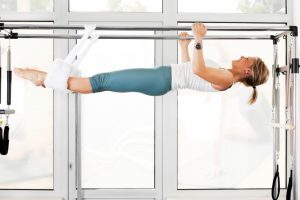Did you know that by practicing the Push-Up Pull-Up phase of your push-up exercises you can improve upper body strength and successfully do a great, get all the way down and back up again push-up?
(This post with tips to improve your push-up pull-up technique is Part 3 of a four-part article series to help you improve your Push-Up Exercises)
 If you haven’t read my previous articles in this series, you might want to check those out first; Push-Up Prep and Practice Better Push-Ups.
If you haven’t read my previous articles in this series, you might want to check those out first; Push-Up Prep and Practice Better Push-Ups.
I was helping a client improve their Push-Ups recently and had a cool A-Ha moment. We were working on improving her upper body strength to maintain a better Push-Up position, working in a full range of motion to lower the body down in one long, strong piece. We spend almost ALL day using our arms in front of the body. Push-Ups, Bench Press in the weight room, or Chaturanga in Yoga class are all different forms of a Push Up. I see so many people struggle with good form to get down (and back up) for a good Push-Up. Who has ever cued you to pay attention to the work that’s happening behind your back — with your arms, shoulders, and upper back to control lower the body down for your Push-Up Exercises? Let’s talk about the Push-Up Pull-Up phase of this exercise…
It’s funny, I like to do hanging Pull-Ups in a Plank Position for my circuit workouts at the park on the playground equipment. And when my husband joins me for a workout, he hates this exercise. It’s difficult to do a hanging Pull-Up because it’s basically a rowing exercise against your body weight (a reverse Push-Up because the back is doing all the work). On the Pilates Cadillac, we have a version of this exercise too; usually reserved for more experienced “advanced” clients and a slightly easier version standing on the Cadillac (the Spread Eagle). After 40 plus years of coaching experience and 22 years of teaching Pilates, I have a newfound appreciation of hanging Pull-Ups and the huge benefit they can offer to help you improve your Push-Ups. Are you ready to take your understanding of Push-Up exercises to the next level?
Not everybody needs to dash out to the park to play on the playground (although if you feel inspired after reading this, go for it!). However, I do want to share with you some things to think about from a technique standpoint for why paying attention to the Pulling/Lowering Phase of your Push-Up exercise is important.
Push-Up Pull-Up –the MOVEMENT Overview
- Swing the Upper Arms Along the Sides of the Ribcage (From in Front of the ribcage, to behind the ribcage)
- Use your Upper Back Muscles to Actively Control Lowering the Body Down (Think about the muscles and movement you use to do a seated Rowing Exercise) Instead of gravity winning and you falling down, actively PULL yourself down – aka controlled descent using your back.
- Find and use your Low Abs and Serratus without letting go of the Multifidi to Lift the Body UP
- Lift the Body UP away from the hands by spreading the shoulder blades and lifting the whole body, instead of pushing the hands into the floor and straightening the elbows to get up. Again, getting back up doesn’t start from the Pecs, it starts in front with the Low Abs. Then the movement is initiated from the BACK of the body; with the shoulder blades spreading apart to lift the body up through the blades.
- Keep your Weight In LOW Center. Maintain more of your body weight back in the Hips, Core, and Feet. Then, throughout both the lowering and lifting phase, this makes it possible to actually move the blades, arms, and shoulders.
- Chest, Neck, and Head all lengthen through the hands without shifting body weight forward onto the hands. (More Lats, Low Traps, and Lengthening upper Spine Extensors. Less Upper Traps, let go of tight Pecs, and avoid too much work with the Anterior Deltoids.)
- The angle of movement is a diagonal line – down and forward, up and back.
A Push-Up is a SWING of the Ribcage through the Upper Arm Bones, moving from under the armpits on a strong, stable, spine that is held in a good (moving plumb line) standing Posture position.
The Lowering Phase: To swing the arms backwards and lower the body, the upper arm moves behind the torso. As this happens, the shoulder blades glide down and together. DO NOT START YOUR DESCENT BY PINCHING THE BLADES TOGETHER! The shoulder blades come together because the arms are moving behind the body. The Upper Back engages to control lowering the torso thru. The Chest opens and stretches as you get closer to the floor.
The Lifting Phase: To return to the Push UP position, low Abs lift to initiate and the spine and ribcage lift too. Maintain the strong long diagonal line from the head to the toes. To lift (Push-UP) the shoulder blades spread first and the upper arms move from behind the torso to in front, because the ribcage is lifting UP away from the floor (Serratus). If you find and use all the right muscles in harmony, you will almost “float” up off the Mat to your UP position rather than struggle to get there!
I want to know how you feel when you think more about what your upper back is doing to pull your body through your arms to lower you down. Even if you don’t work on the lifting phase to get back up just yet. How much easier is it to maintain good alignment and get to the ground because your back is doing a better job to move you? Love to hear from you… Hope this simple training tip helps make a difference for your Push-Up exercises?
*****
A fabulous way to focus on the push-up pull-up, pulling phase of your push-up exercises is with the Pulsing Push-Up exercise from the Pulse-Power Daily Dozen 10-minute Workout Plan. ALL the exercises in this quick at-home workout can help improve the deeper levels of strength and stability needed for a great push-up. Snag a copy of Pulse-Power ebook now and start incorporating the Pulse-Power Daily Dozen exercises into your training program to help get more from your core and improve your Push-Up exercises.


0 Comments